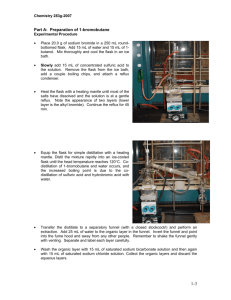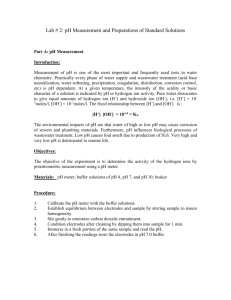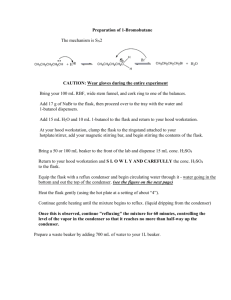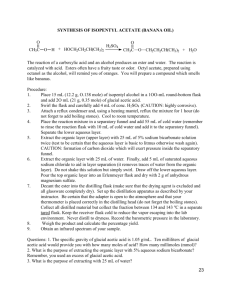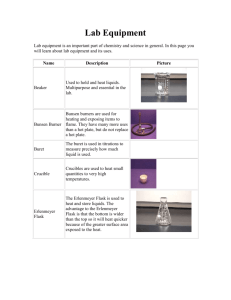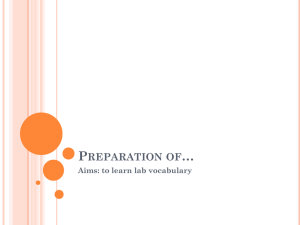Experiment 7 Preparation of 1-Bromobutane
advertisement
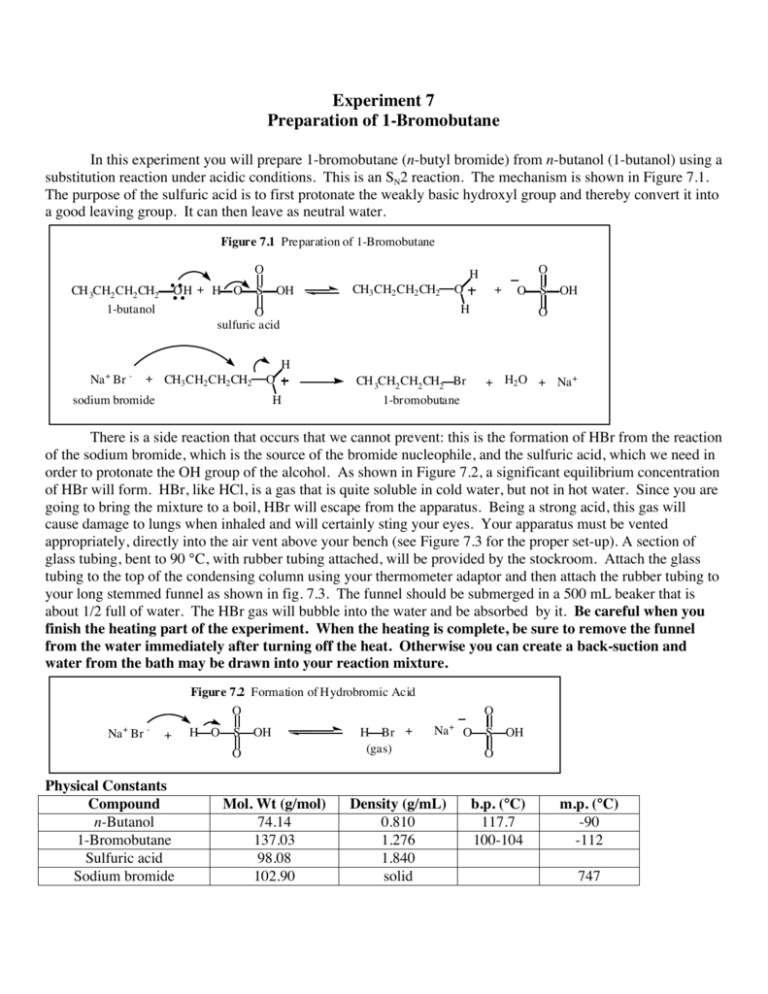
Experiment 7 Preparation of 1-Bromobutane In this experiment you will prepare 1-bromobutane (n-butyl bromide) from n-butanol (1-butanol) using a substitution reaction under acidic conditions. This is an SN2 reaction. The mechanism is shown in Figure 7.1. The purpose of the sulfuric acid is to first protonate the weakly basic hydroxyl group and thereby convert it into a good leaving group. It can then leave as neutral water. Figure 7.1 Preparation of 1-Bromobutane O OH + H O CH 3CH2 CH2 CH2 1-butanol O H S OH CH3 CH2 CH2 CH2 O + O H O sulfuric acid S OH O H Na + Br - + CH3 CH2 CH2 CH2 O sodium bromide H + H2 O + Na + CH 3CH2 CH2 CH2 Br 1-bromobutane There is a side reaction that occurs that we cannot prevent: this is the formation of HBr from the reaction of the sodium bromide, which is the source of the bromide nucleophile, and the sulfuric acid, which we need in order to protonate the OH group of the alcohol. As shown in Figure 7.2, a significant equilibrium concentration of HBr will form. HBr, like HCl, is a gas that is quite soluble in cold water, but not in hot water. Since you are going to bring the mixture to a boil, HBr will escape from the apparatus. Being a strong acid, this gas will cause damage to lungs when inhaled and will certainly sting your eyes. Your apparatus must be vented appropriately, directly into the air vent above your bench (see Figure 7.3 for the proper set-up). A section of glass tubing, bent to 90 °C, with rubber tubing attached, will be provided by the stockroom. Attach the glass tubing to the top of the condensing column using your thermometer adaptor and then attach the rubber tubing to your long stemmed funnel as shown in fig. 7.3. The funnel should be submerged in a 500 mL beaker that is about 1/2 full of water. The HBr gas will bubble into the water and be absorbed by it. Be careful when you finish the heating part of the experiment. When the heating is complete, be sure to remove the funnel from the water immediately after turning off the heat. Otherwise you can create a back-suction and water from the bath may be drawn into your reaction mixture. Figure 7.2 Formation of Hydrobromic Acid O Na + Br - + H O S OH O Physical Constants Compound n-Butanol 1-Bromobutane Sulfuric acid Sodium bromide Mol. Wt (g/mol) 74.14 137.03 98.08 102.90 H Br + (gas) O Na Density (g/mL) 0.810 1.276 1.840 solid + O S OH O b.p. (°C) 117.7 100-104 m.p. (°C) -90 -112 747 Procedure: The set-up is shown in Figure 7.3. Place 25 mL of 65% sulfuric acid solution in your 250 mL round bottom flask. Be careful to use the 65% H2SO4 and NOT the 85% material that is available for a subsequent part of the experiment. Using the wrong concentration leads to unpredictable and potentially dangerous results. Cool the flask to 5 –10 °C in an ice bath. Be sure to clamp your flask in place since an unsupported flask in an ice bath can tip over when the ice melts. When the solution is cold (5 -10 °C) slowly add 10 mL of 1-butanol a few mL at a time using a pipette or medicine dropper. After each addition thoroughly mix and cool the solution in the ice bath. When all of the 1-butanol has been added, weigh out 12.5 g of solid sodium bromide (NaBr) in a small beaker. Slowly add the solid sodium bromide in small portions. A good way to do this is to crease a piece of weighing paper and use this as a funnel, scraping the solid material into your flask using your spatula. As you add the solid NaBr, swirl the flask in order to thoroughly mix it. The sodium bromide will only partially dissolve. When all of the NaBr has been added use your spatula to remove any solid material that is adhering to the inside of the ground glass joint of your 250 mL round bottom flask. “Wet” the spatula in the solvent and use this to dissolve the solid material or wipe the joint with a piece of wet paper towel several times. It is very important to remove this solid so that you get a tight fit between the 250 mL flask and the distilling column. Otherwise HBr gas may escape into the laboratory. Figure 7.3 Glass tubing Ground glass + rubber thermometer adaptor Rubber tubing Condensing column Water out Water in metal clamp to iron bars Funnel Cork Beaker containing water 250 mL flask Heating mantle plug to wall socket Rheostat Attach the distilling column and glass absorption trap as shown in Figure 7.3. Add 2-3 boiling chips and heat the flask to a gentle reflux using a setting of about 60 on the rheostat. Again, the exact setting depends on the size of the heating mantle, etc. Do not heat too quickly as the reaction can get out of control and HBr gas can escape. If you do see HBr gas escaping immediately lower the heating mantle from the flask and call for assistance from your instructor or teaching assistant. Once all of the solid sodium bromide has dissolved, continue heating the reaction at a gentle reflux for about 30 minutes longer. You will see two layers separate. The yellowish brown layer on top is 1bromobutane. It is not soluble in the aqueous H2SO4 layer on the bottom. After 30 minutes of heating, lower the heating mantle away from your reaction flask and immediately also remove the long-stem funnel from the gas absorption bath. Remember, that this prevents a vacuum from forming in your reaction flask as it cools and sucking up water from the bath into your flask. Allow your flask to cool to 40 - 50 °C (warm to the touch is cool enough). You can accelerate the cooling process by using an ice bath. Add 10 mL of H2O and set -up your apparatus for a simple distillation as shown in Figure 7.4. Begin heating again (setting of 60-70 on the rheostat). You will distill a mixture of product (water insoluble) and Figure 7.4 Thermometer Ground glass + rubber thermometer adaptor Water out metal clamp to iron bars Water in Cork 250 mL Round Bottomed Flask 100 mL Round Bottomed Flask Heating mantle plug to wall socket Rheostat water. The 1-bromobutane (density 1.276 g/mL) is heavier than water (density 1.0 g/mL) and so will be on the bottom. Continue distilling until no more organic material is collected. To be sure, remove the 100 mL round bottom flask and collect about 1 mL of distillate in a small test tube that is about 1/2 full of water. If you see only one layer (no insoluble organic material), then you are simply distilling water, all the 1-bromobutane has already boiled over, and you have finished. However, if you see droplets of organic material, you must continue the distillation. This is a convenient place to stop. It is difficult to finish all of the experiment in one period. Stopper your 100 mL round bottom with a suitably sized cork or you can use a 19/22 ground glass stopper. Bromobutane is quite volatile and will evaporate if left in an open container. If you do use the ground glass stopper, be sure to use stopcock grease on your stopper. Otherwise it can freeze in the ground glass joint. When you have stoppered your flask, wrap a small piece of parafilm around the joint. You only need one small piece of parafilm. Fold the parafilm so that it is doubled and then place one end across the joint of the flask and stopper. Hold the flask in one hand and hold down the end of the parafilm with your thumb. Using your other hand, gently stretch the parafilm around the joint until it is secure all the way around. Again, one piece is usually sufficient to make a gas tight seal. If you stretch the parafilm too much, it can break. If this happens get another piece and try again! Place your product in a secure location in your locker. A good place to store it is inside a 400 mL beaker. Discard the liquid that is left in the 250 mL distilling/reaction flask. It can safely go down the sink since it is aqueous material but since it is strongly acid be sure that there is a lot of water flowing so as to wash it down the drain. Work-up: Note: We are going to do a complicated work-up in which you will do several washes of your product. SAVE ALL LAYERS UNTIL YOU ARE FINISHED WITH THE EXPERIMENT AND YOU ARE SURE THAT YOU HAVE ISOLATED THE CORRECT LAYER. Transfer the contents of your 100 mL round bottom (your crude 1-bromobutane) to your separatory funnel. Add 10 mL water (or a volume of water approximately equal to the volume of 1-bromobutane in your separatory funnel) and shake well. Separate the two layers. The water layer is less dense than the 1bromobutane and so will be on the top. Drain the bottom layer (this is the 1-bromobutane) into a flask and then drain the top layer into a separate flask. Pour the 1-bromobutane back into the separatory funnel and add 8 mL of ice cold 80% sulfuric acid. Shake this mixture carefully and thoroughly so as to remove any unreacted 1-butanol that may be present. The sulfuric acid will protonate the 1-butanol and make it soluble in the aqueous sulfuric acid as shown in Figure 7.5. Figure 7.5 Removal of Unreacted 1-Butanol O CH 3CH2 CH2 CH2 OH + H O soluble in 1-bromobutane S O O H OH CH3 CH2 CH2 CH2 soluble in aqueous acid layer O H + - O S OH O After shaking several times, allow the layers to separate. The 80% aqueous sulfuric acid is MORE DENSE than the organic layer and so will be on the bottom. Drain this layer into the flask that contains the previous aqueous layer. CAUTIOUSLY add 8 mL of saturated sodium bicarbonate. You must be careful with this step. Severe pressure of CO2 can build up when the sulfuric acid droplets remaining from the previous wash are neutralized by the sodium bicarbonate. Add a few mL of the sodium bicarbonate solution and then swirl the separatory funnel. DO NOT CLOSE THE FUNNELWITH THE STOPPER YET. Continue swirling the separatory funnel with the stopper off until you see that all bubbling of CO2 has ceased. Also, stir the two layers vigorously with your glass stirring rod. Add the rest of the sodium bicarbonate and swirl again until all bubbling has ceased. Now close the separatory funnel and GENTLY INVERT THE FUNNEL AND VENT IMMEDIATELY. Do not shake it vigorously all at once as pressure can build up (just like shaking a can of soda!!). Once you have vented the funnel, shake once or twice and then vent again. Shake more vigorously, vent, shake, vent until you no longer hear the sound of gas escaping from the vented funnel. When you are venting your separatory funnel be sure that YOU ARE NOT POINTING THE FUNNEL AT YOUR NEIGHBOR!! In this case the bottom layer is the organic layer. Drain off the bottom layer into a flask and then drain the top layer into a separate container (do not add this to the previous aqueous layers since they are acidic and this layer still contains sodium bicarbonate base). Add the organic layer back to the separatory funnel and add 8 mL water. Shake vigorously, drain off the bottom organic layer into a clean, dry 50 mL Erlenmeyer. Cover the bottom of this flask with anhydrous calcium chloride, stopper the flask with a cork and allow to sit for 10 - 15 minutes, with occasional swirling, while you set up the apparatus for a final simple distillation using the set-up shown in Figure 7.6. Use a clean dry 50 mL round bottom for the distilling flask and a dry 25 mL round bottom for the receiving flask. Collect material that boils between 99-103 °C. Discard any material that boils below or above this range. Determine the weight of your material and calculate the percent yield. Turn in the product in a labeled vial and submit your Organic Yield Report Sheet. Figure 7.6 Thermometer Ground glass + rubber thermometer adaptor Water out Water in metal clamp to iron bars 100 mL Round Bottomed Flask 50 mL Round Bottomed Flask plug to wall socket Heating mantle Rheostat
